Bachmann Missouri Pacific Herbie Safety Car
Published: 2024-03-01 - By: CNW400
Last updated on: 2024-02-26
Last updated on: 2024-02-26
visibility: Public - Headline
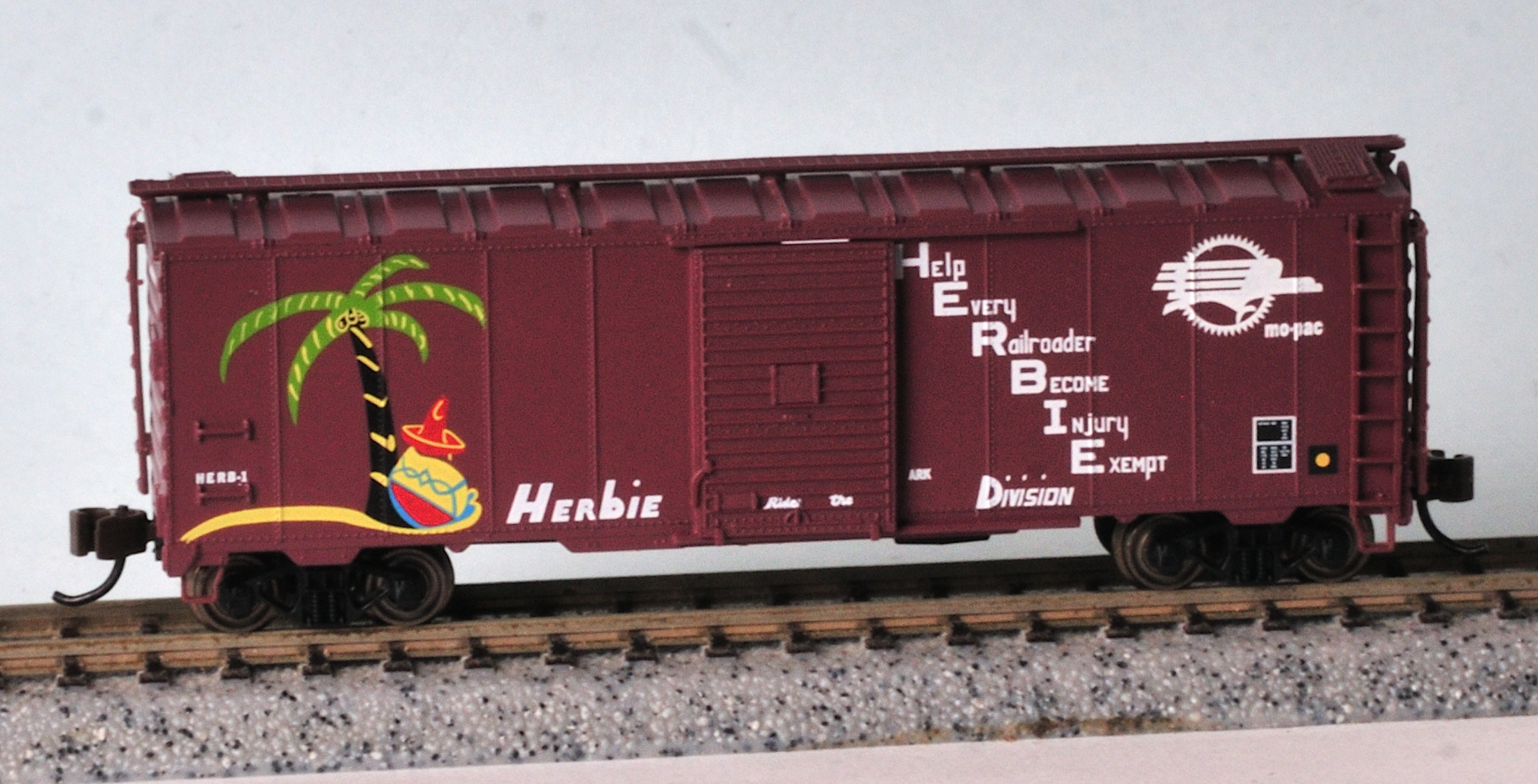
Introduction
We have all seen the over-the-top grainy black-n-white railroad training safety videos on YouTube. Or the brightly colored caboose with slogans to be vigilant and that practicing safety is YOUR responsibility. A more modern example would be the Union Pacific Railroad founded Operation Lifesaver campaign. Introduced in 1972, Union Pacific launched the ‘Stop, Look and Listen’ public awareness program to highlight the dangers around railroad crossings, train tracks, and rail owned property. Operation Lifesaver - now a 501(c)(3) educational organization sponsored by government agencies, American railroads, and highway safety institutions - has updated their message to ‘Look, Listen, Live!’.The acknowledgment and wrangling for railroad employee safety has roots over 130 years old. During the infancy of the railroads, precautions were often ignored in the name of profit and rapid expansion. Employees were often poorly trained and overworked. Inadequate track and bridge construction caused derailments and accidents. Untrustworthy equipment exploded or failed to brake properly. Unsafe rolling stock movements and coupling procedures caused loss of limbs or even death. According to the Railroad Gazette – Issue February 8, 1893, an average of 741 rail workers were killed and 2,635 injured annually for the years 1890 thru 1892. This led to the formation of The Safety Appliance Act of 1893 – the first of several congressional safety measures to be implemented over the next 100+ years.
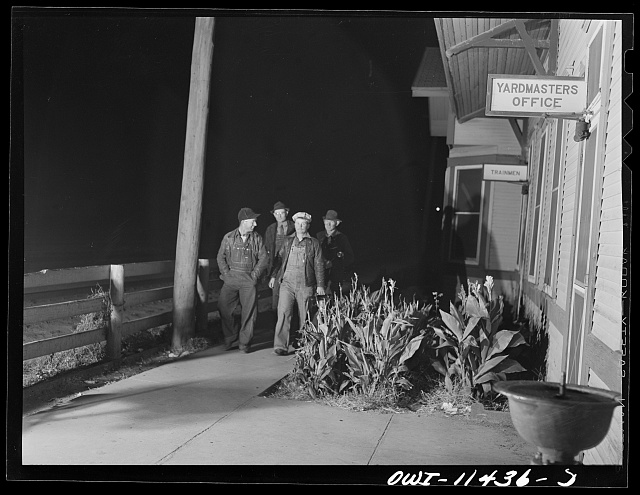
Fast-forward almost 80 years and safety is still a major concern with the passage of The Federal Railroad Safety Act of 1970. Approved by Congress, the Act was to (amongst other points): “promote safety in all areas of railroad operations and to reduce railroad-related accidents, and to reduce deaths and injuries to persons and to reduce damage to property caused by accidents....”
This brings us to the era of our subject – the Missouri Pacific (MoPac) HERBIE Safety Car. Seeking an idea for a new safety awareness slogan, the Missouri Pacific Railroad Arkansas Division promoted an employee contest in 1979 looking for suggestions. A design by David Newborne, a carman from Memphis, was selected. Fashioned after the chalk drawings of a St. Louis, Missouri car inspector, Mr. Newborne’s composition featured a male figure resting under a palm tree wearing an oversized sombrero and sarape. The figure was named Herbie, and the boxcar featured the message: Help Every Railroader Become Injury Exempt. The railcar was given the road marker of HERB-1.
The originator of the Herbie character was Herbert Meyer, an employee of both the Missouri Pacific Railroad and The Terminal Railroad Association of St. Louis (TTRA). During his time working for the railroads, Mr. Meyer was known for “tagging” the cars he either inspected or switched with a chalk sketch of the sombrero wearing man under a five-point palm tree. The drawing was dated and labeled Herby (notice spelling). It is rumored that Mr. Meyer drew on 10’s of thousands of railcars during his employment from the 1950’s to early 1980’s and his handiwork took him seconds to complete.
The Prototype
Missouri Pacific railcar MP 129685, awaiting repairs in the MP shop, was chosen to be the recipient of the new paint job. During the month of May 1979, the car received a fresh coat of boxcar red and the Herbie paint scheme. The Missouri Pacific boxcar was from a series of older Pacific Car & Foundry (PC&F) ice reefers that were rebuilt into standard 40-foot boxcars by MoPac shops from 1968 to 1975. The boxcars featured a single door, full ladders, no roofwalk, and rode on roller bearing trucks.There lies a mystery with the non-revenue safety education Herbie boxcar – there are two different paint versions found with Missouri Pacific markings. One version features a white MoPac Turbo Eagle logo with a five-pointed palm tree. The other photographed image has a red and white MoPac Buzzsaw decal with a four-point palm tree. Both cars are marked Herb-1. I have found several sources defending each possibility - either two completely different boxcars featuring the Herbie paint scheme with variants or the same boxcar with an updated scheme executed sometime during the 1980s. Since the original Herb-1 car was created in 1979 and the Union Pacific-Missouri Pacific merger was approved in 1982 (although not fully completed until 1997) - my thoughts are these are two different boxcars with the belief neither railroad would approve a full repaint job during the merger transitional period.
Either way, Herb-1 was teamed with Missouri Pacific caboose MP East One. A converted drover caboose (caboose used on livestock unit trains – stockman/animal handlers rode in this car) with an educational classroom and displays. The caboose was red with a large white turbo eagle logo.
Today Herb-1 still survives after the UP-MP merger. The Union Pacific version sports a four-point palm tree and UP Shield logo. This supports my theory of two Herb-1 cars in existence at one time with the Buzzsaw/four-point palm tree car modified with the UP Shield herald once the merger was fully achieved. East One also continues to serve, painted red with the UP Shield and Operation Lifesaver lettering.
Safety legislation and education has tremendously reduced the number of employee work-related deaths with the Federal Railroad Association (FRA) reporting only 10 railroad worker fatalities in 2022 (the last reporting year). Currently, trespassing is the number one cause of railroad related deaths with 651 in 2022 per the FRA.
Road Names and Pricing
Bachmann Trains currently offers nine AAR (Association of American Railroads) 40-Foot Steel Boxcars for sale in their latest merchandise catalog. All of these boxcars belong to their Premium Silver Series® Rolling Stock Collection – a more highly detailed model complete with metal wheels, body mounted couplers, and separately applied parts.- Baltimore & Ohio – Timesaver
- Bangor & Aroostook – State of Maine Products
- Great Northern
- Missouri Pacific – Herbie Safety Car
- New York, Susquehanna & Western – Suzy Q
- Pennsylvania – Merchandise Service
- Union Pacific – Automated Railway
- Wabash
- Western Pacific – Feather Car
The Model
The ready-to-run boxcar arrived in an oversized clear plastic jewel case with a slip-off cover. Nestled between a sturdy two-piece plastic cradle we find the model and a small plastic bag containing a pair of Rapido couplers for those wishing to replace the equipped E-Z Mate ® couplers. All information is neatly labeled on the end of the case for easy identification when placed into storage.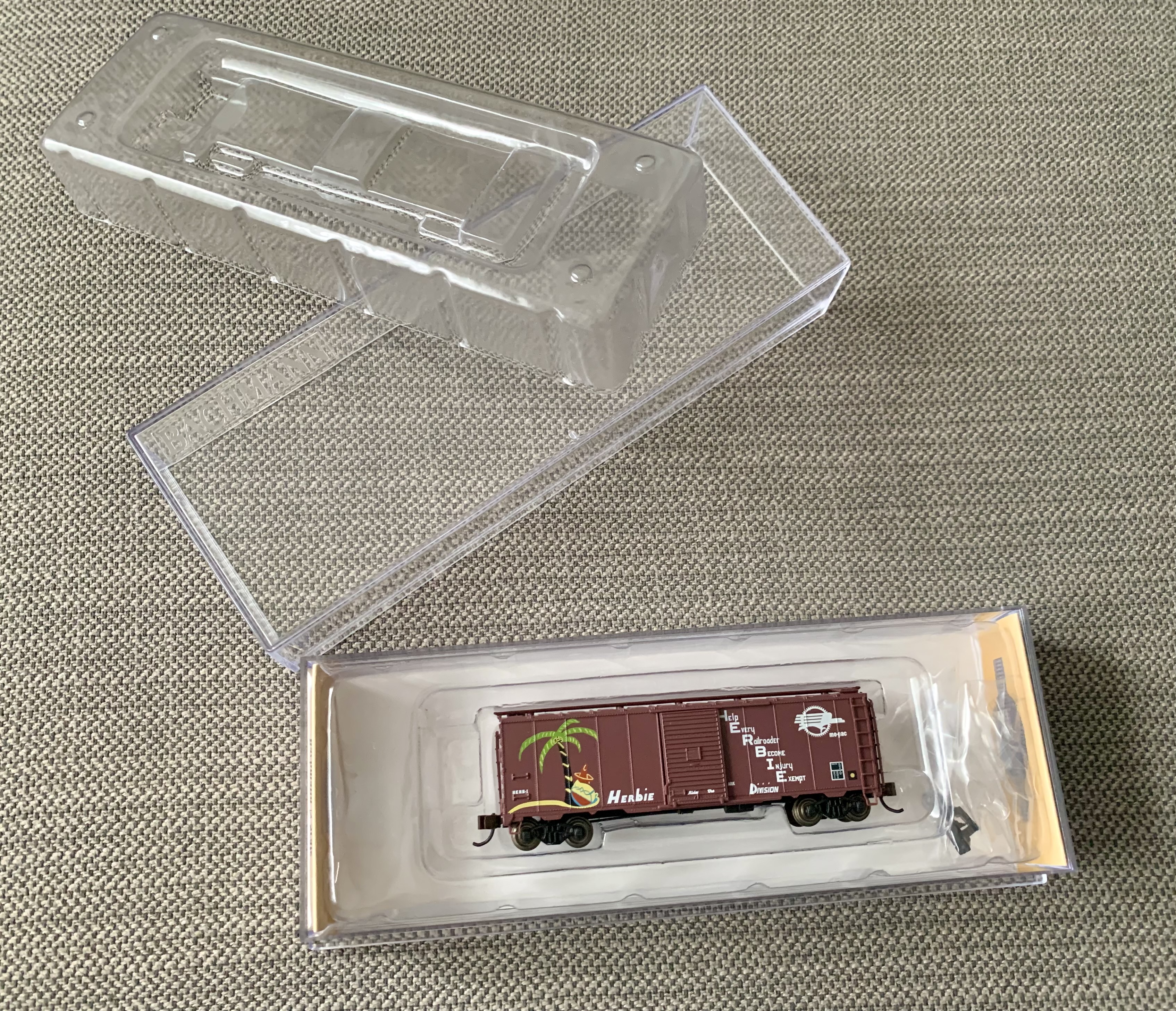
The boxcar red paint job is crisp and even along the injection molded plastic model. The Missouri Pacific features white lettering, a MoPac Turbo Eagle logo, and the brightly colored Herbie figure with palm tree. All characters and images are neat, legible, and in the proper font and location when compared to photographs of the real-life Herb-1 boxcar.
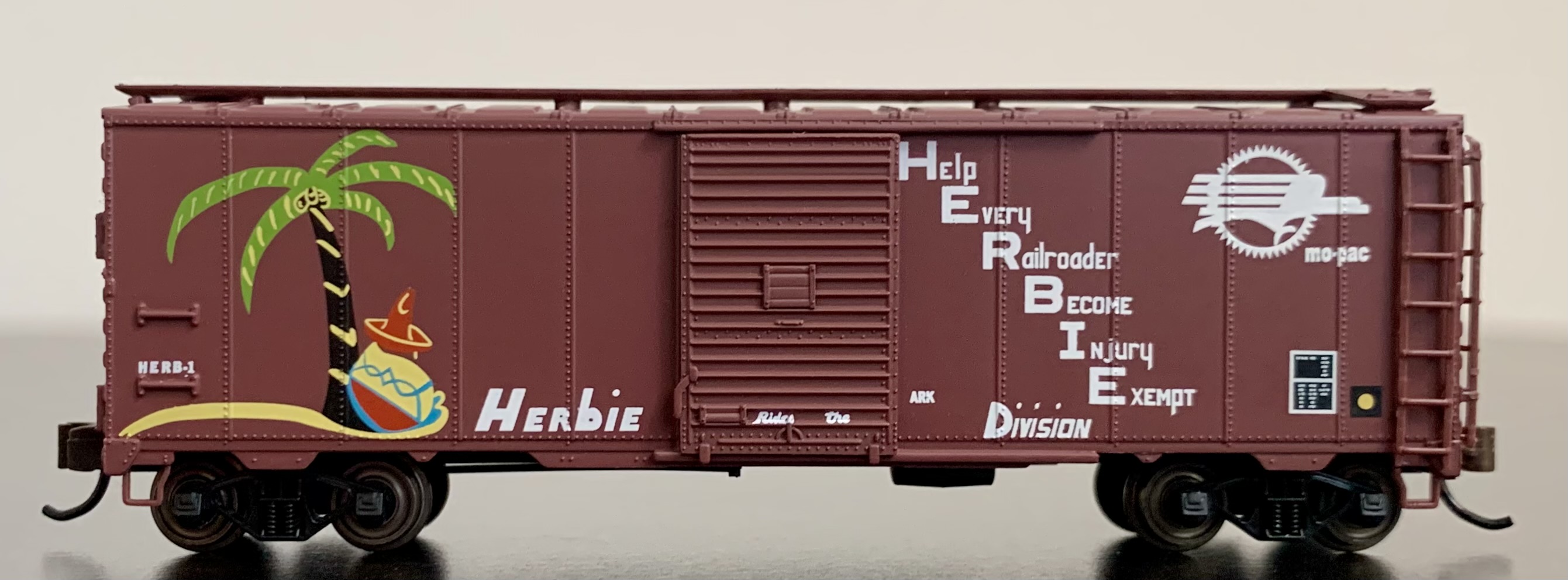
Furthermore, the Bachmann Trains model resembles the Missouri Pacific Herbie safety car with a 5x5 steel panel arrangement on each side of the 6-foot Youngstown corrugated door, seven rung full ladder, and two rung grab iron patterns. The Bachmann model also has the correct 5-point palm tree image and ‘Herbie Rides the ARK (Arkansas) Division’ slogan. I am impressed with the sharp, neat rivet lines on the model. Both sliding side doors with lift handles are operational and reveal a black wooden plank floor inside the boxcar. Lastly, prototype correct AAR tab side sills are found on the Bachmann car.
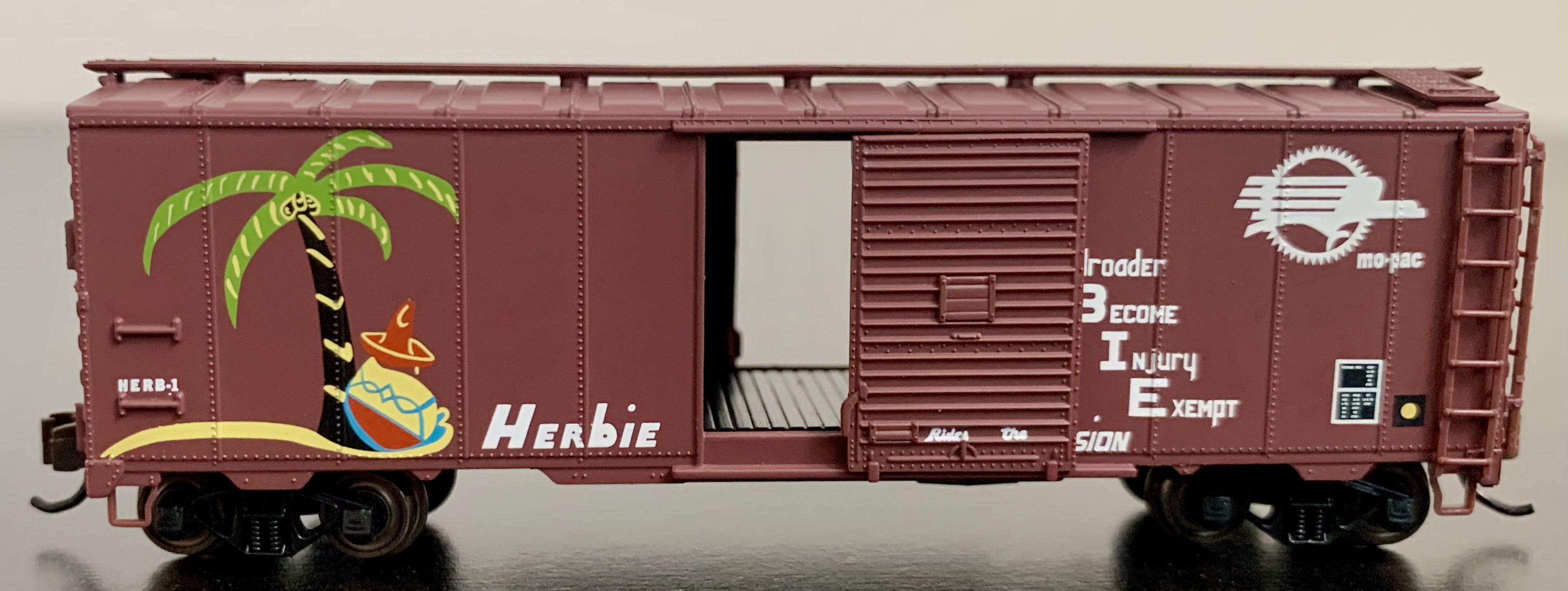
The Bachmann car is fitted with the correct version of Camel Sales Company Youngstown door. The model’s three section 5/6/6 Youngstown door has single route board mounted in the middle section – the prototype has two boards located on the lower panel section. Lastly, images of the real Missouri Pacific safety car show an air conditioner vent in one of the side panels – this is not present on the model.
The yellow dot inside the black square (U-1 inspection dot) is a prototypical correct marking. In the mid-1970s, 33"-wheel sets manufactured by the Southern Wheel Company were believed to be defective. In March 1978, all boxcars were inspected and those railcars with Southern Wheels were not allowed to haul hazardous materials. These cars were stenciled with a white dot inside a black square until the wheel sets were replaced with an approved style. Beginning in January 1979, those boxcars with white dots could not be used on any interchange service until replaced. Yellow dots were marked on boxcars with approved wheel sets, those cars that have been replaced with proper equipment or any new boxcar manufactured after the inspection phase began. The U-1 dot system lasted until all suspected boxcars with defective wheels were believed to be replaced by 1981.
The ends of the Bachmann railcar feature a 4/5 Dreadnaught pattern with non-tapering ribs. Both ends have the prototypical correct 7-rung full ladder, mid-mounted tackboard, and HERB-1 road marker shown in the upper right corner. The B-end of the model shows a brake platform, a nondescript brake wheel, and nice, molded brake chain with piping detail. Some of these details are incorrect when compared to the Missouri Pacific HERB-1.
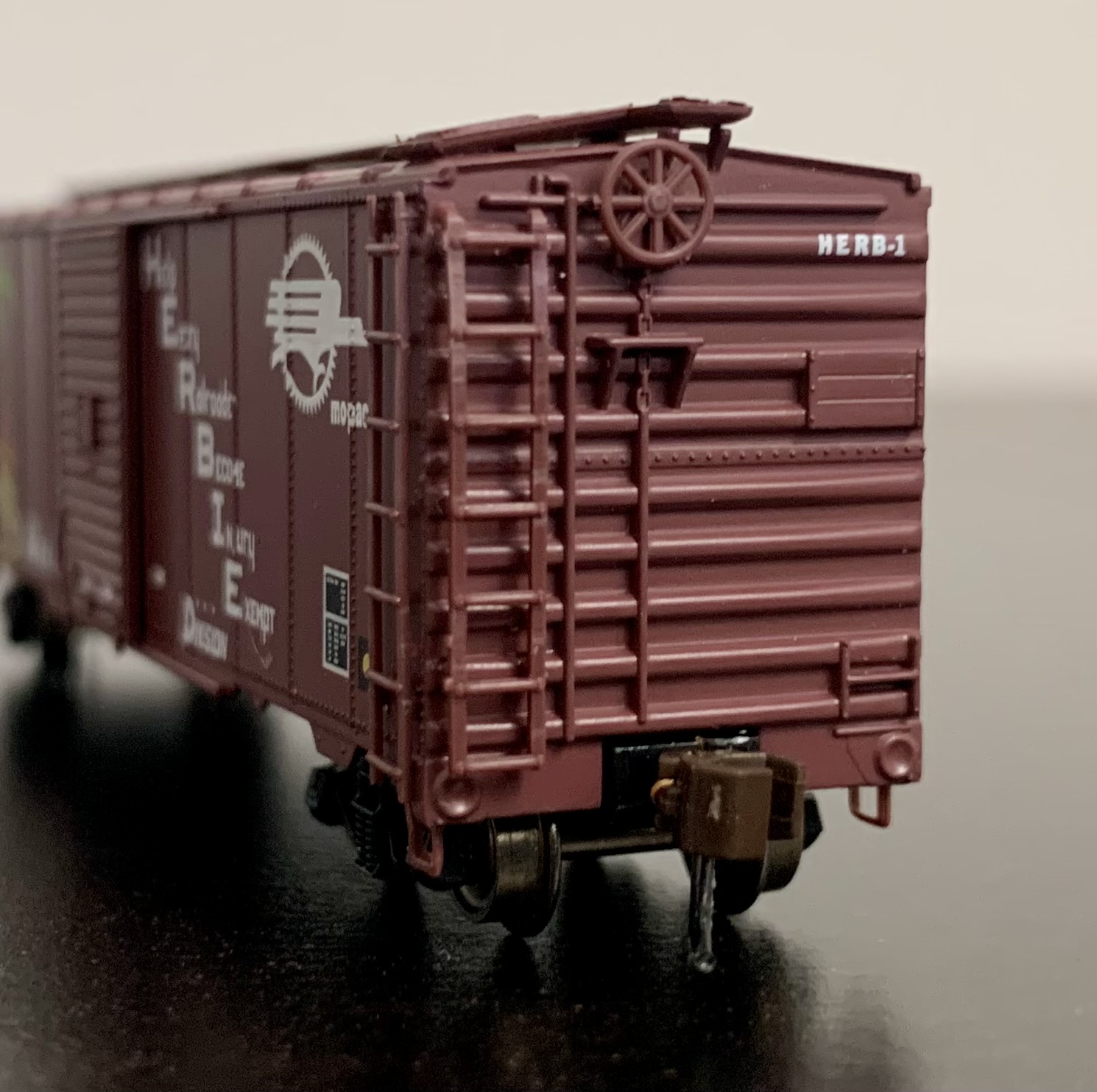
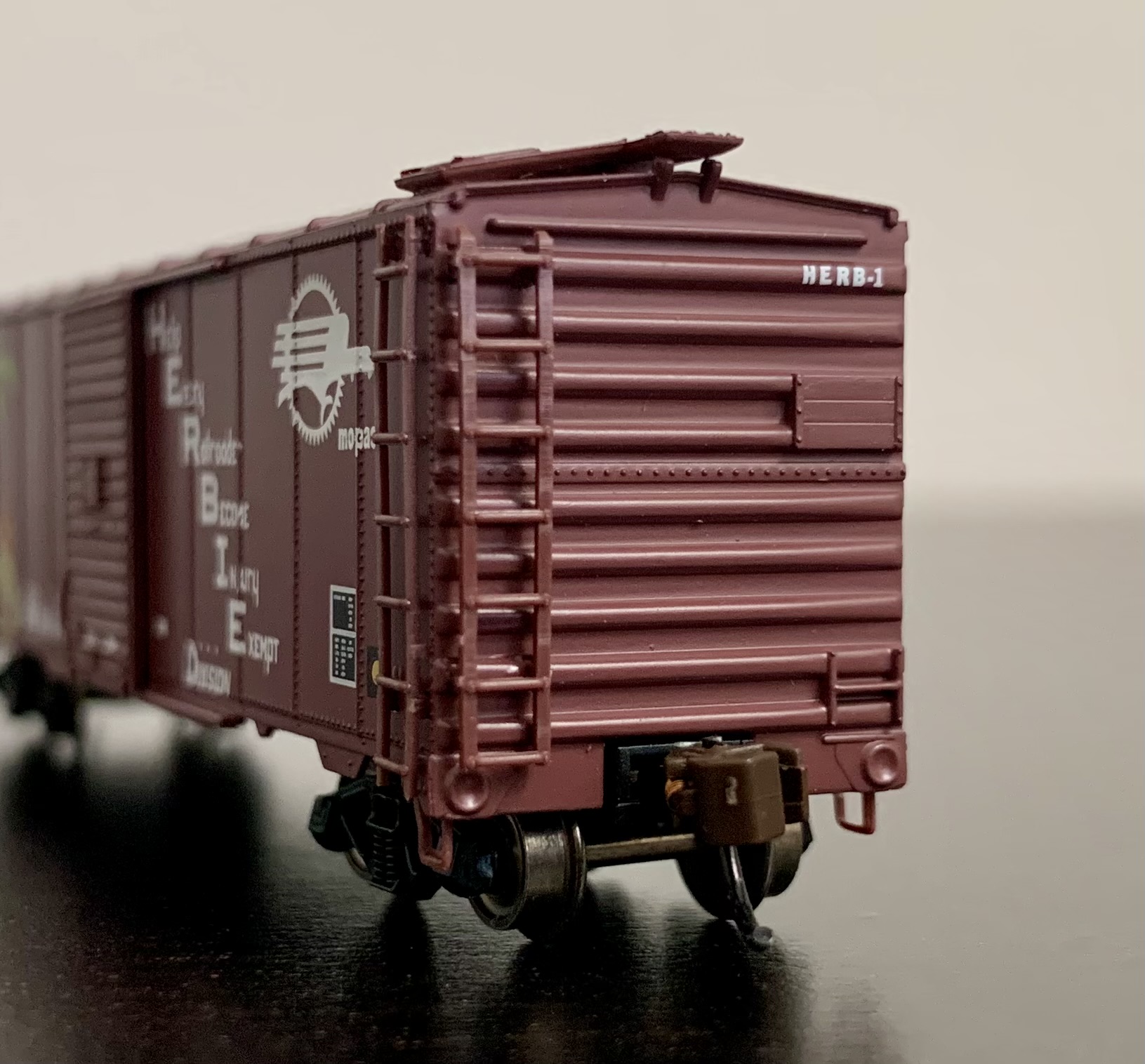
The true HERB-1 safety car has a 4/4 Dreadnaught configuration with side darts between each corrugation. The brake wheel appears to be either an Ajax or Miner model in photographs, the tackboards are mounted low, and the A-end has a short 4-rung ladder.
The top of the boxcar exhibits a raised 12-panel Murphy metal roof with an Apex running board with latitudinal extensions. Although a proper roof configuration for this era of AAR boxcars – the rebuilt Herbie boxcar did NOT have a roofwalk applied in real life. For those wishing to model with prototypical correct equipment, it is another example of a manufacturer trying to fit a specialty car into an established series without regards to variations. Roofwalks were not mandatory on equipment built or rebuilt after 1966, with a target date of 1974 to have all running boards removed. This deadline was later extended to 1983.
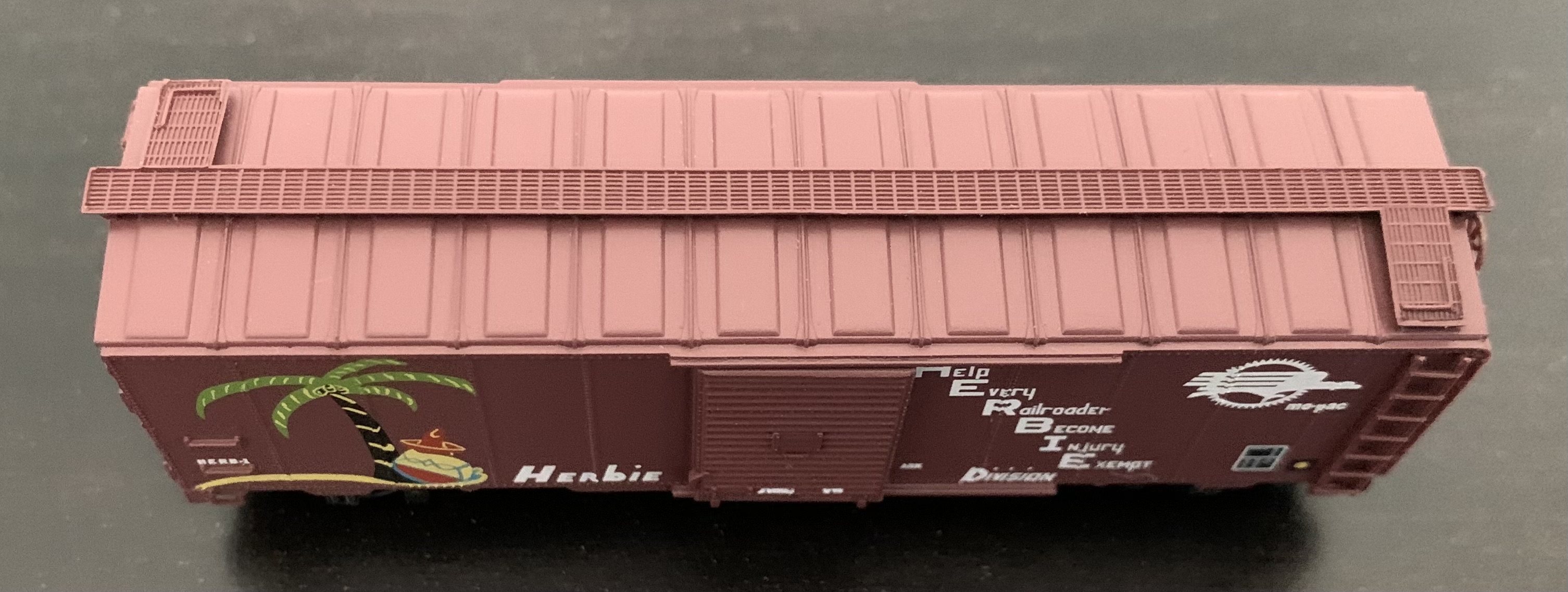
The black plastic underframe features a separately applied AB braking system with brake cylinder, AB valve, brake reservoir, and brake rods. The safety car is furnished with pin mounted Bettendorf trucks and blackened metal wheels with RP-25 contours. The model is also supplied with brown body mounted magnetically operated E-Z Mate® couplers – both measured at the proper height.
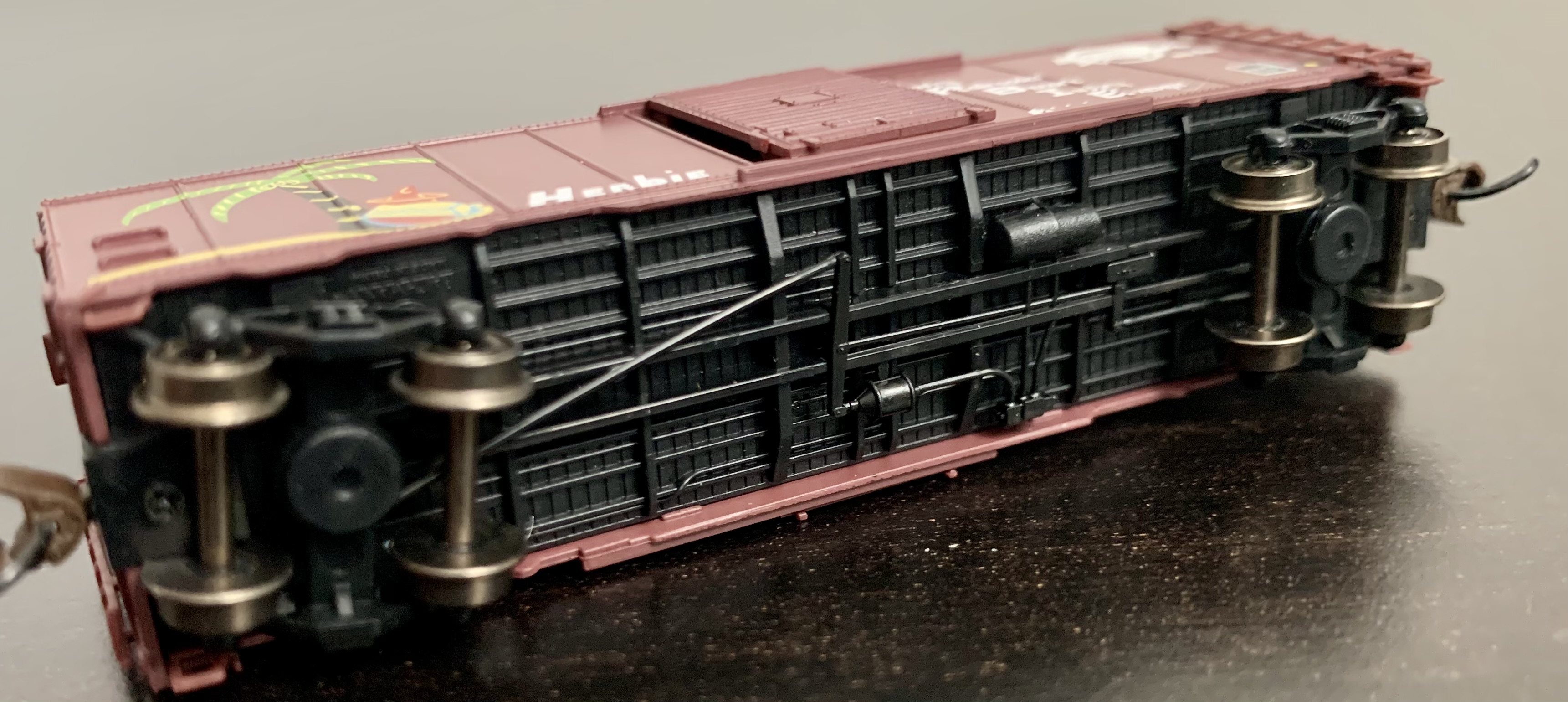
The boxcar is 3 inches in length and weighs 0.8 ounces, which is too light according to the National Model Railroad Association (NMRA) recommendations of 0.97-1.0 ounce for a model car this size. I did find it an excellent runner on Kato Unitrack with no issues around curves or through turnouts at slow and medium speeds. I especially liked the smooth-running metal wheels and the realism of the clickety-clack sound that resonates from them.
Conclusions
In short, a respectable release with a steep suggested retail price. Strong color graphics, metal wheels, operational doors, and body-mounted couplers are commendable touches. But slapping an image on the side of a generic boxcar and classifying it as a specialty item without attempting to make alternations to match the prototype railcar (example – running boards & car ends) is a little passive for a $40 premium model. The boxcar does run well without the need to make adjustments. If you like the concept behind the Herbie illustration and watching the vibrant colors whiz past – Bachmann offers a solid product. Looking for prototype model railroading – you may be a tad disappointed.Editor's Note: This is not the first time this car has been modeled in N Scale. Micro-Trains released a car in 2020 representing the same prototype. You can find the link here: MTL Herbie Car.
To see a list of all items in this series, CLICK HERE

